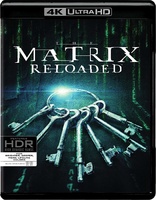The Matrix Reloaded 4K Blu-ray Movie
HomeThe Matrix Reloaded 4K Blu-ray Movie 
4K Ultra HD + Blu-ray + Digital CopyWarner Bros. | 2003 | 138 min | Rated R | Oct 30, 2018
Movie rating
7.1 | / 10 |
Blu-ray rating
| Users | 4.9 | |
| Reviewer | 3.5 | |
| Overall | 3.5 |
Overview
The Matrix Reloaded 4K (2003)
Neo, Morpheus, Trinity, and the rest of their crew continue to battle the machines that have enslaved the human race in the Matrix. Now, more humans are waking up out of the matrix and attempting to live in the real world. As their numbers grow, the battle moves to Zion, the last real-world city and center of human resistance.
Starring: Keanu Reeves, Laurence Fishburne, Carrie-Anne Moss, Hugo Weaving, Jada Pinkett SmithDirector: Lilly Wachowski, Lana Wachowski
| Action | Uncertain |
| Adventure | Uncertain |
| Sci-Fi | Uncertain |
| Thriller | Uncertain |
| Epic | Uncertain |
| Martial arts | Uncertain |
| Surreal | Uncertain |
Specifications
Video
Video codec: HEVC / H.265
Video resolution: 4K (2160p)
Aspect ratio: 2.40:1
Original aspect ratio: 2.39:1
Audio
English: Dolby Atmos
English: Dolby TrueHD 7.1 (48kHz, 24-bit)
English: Dolby Digital 5.1 (640 kbps)
French: Dolby Digital 5.1 (640 kbps)
German: Dolby Digital 5.1 (640 kbps)
Italian: Dolby Digital 5.1 (640 kbps)
Spanish: Dolby Digital 5.1 (640 kbps)
Spanish: Dolby Digital 2.0 (192 kbps)
Portuguese: Dolby Digital 2.0 (192 kbps)
Czech: Dolby Digital 5.1
Hungarian: Dolby Digital 5.1 (640 kbps)
Polish: Dolby Digital 5.1 (640 kbps)
Russian: Dolby Digital 5.1
Thai: Dolby Digital 5.1 (640 kbps)
Turkish: Dolby Digital 5.1 (640 kbps)
Japanese: Dolby Digital 5.1
Japanese: Dolby Digital 2.0 (192 kbps)
Spanish=Castillian 5.1 and Latin 2.0; Japanese is hidden
Subtitles
English SDH, French, German SDH, Italian SDH, Japanese, Portuguese, Spanish, Arabic, Croatian, Czech, Danish, Dutch, Finnish, Greek, Hungarian, Korean, Mandarin (Traditional), Norwegian, Polish, Romanian, Russian, Thai, Turkish
Discs
Blu-ray Disc
Three-disc set (3 BDs)
Digital copy
4K Ultra HD
Playback
Region free
Review
Rating summary
| Movie | 2.5 | |
| Video | 5.0 | |
| Audio | 5.0 | |
| Extras | 0.0 | |
| Overall | 3.5 |
The Matrix Reloaded 4K Blu-ray Movie Review
Welcome Back, Mr. Anderson. Surprised to See Us in 4K? (No, Not Really.)
Reviewed by Michael Reuben November 3, 2018After its breathtaking 4K revival
of The
Matrix earlier this year, it was inevitable that Warner
Brothers would also release the two disappointing sequels on UHD. Confirmed fans could be
expected to buy the entire trilogy, if only for the sake of completeness, and having assembled the
A-plus team of DP Bill Pope and MPI colorist extraordinaire Jan Yarbrough to regrade the varied
palettes of Neo's initial outing in HDR and Dolby Vision, why not have them complete the
hero's journey to its final, Christ-like destination? Warner is now releasing both of the
Wachowskis' sequels on UHD, as well as a three-film
set for those who held off purchasing the
original film, sagely anticipating that additional titles were just around the corner.
Messrs. Pope and Yarbrough have done the same stellar work on the imagery of both Reloaded
and Matrix Revolutions
that we have
already seen in their handling of the first film, and the
trilogy's original sound team has done a similarly creditable job in remixing the aggressive
soundtracks for Dolby Atmos. Unfortunately, after the technical crews completed their work, it
was turned over to the same species of clueless Warner executive who assembled the botched
package for the Blade
Runner UHD.
Whatever you do, hold onto your existing Blu-rays. While
the UHD iterations of the two Matrix sequels are worthy representatives of the format—whatever
one may think of their quality as films—unless this is your first time buying The Matrix sequels
on Blu-ray, you can take the two 1080p discs in each three-disc set and use them as coasters.
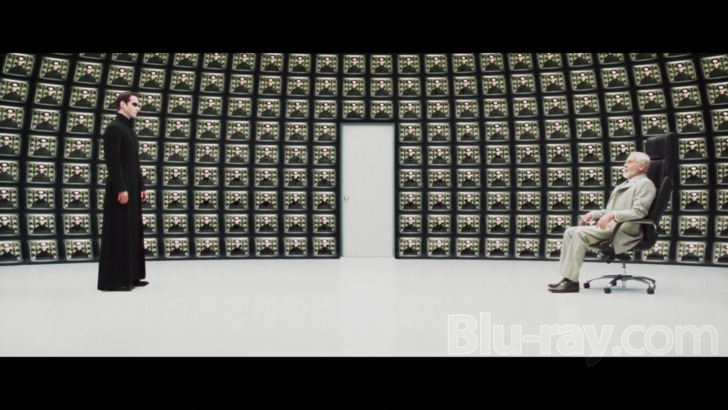
Much ink and many electrons have been spilled over the disappointment that greeted the two Matrix sequels (filmed simultaneously and released six months apart in 2003), and I have little to add except that I saw both in their initial theatrical outings and was astonished at how the original film's suggestive notions had ballooned into such pseudo-philosophical, quasi-religious claptrap. Blu-ray.com's 2008 review of The Ultimate Matrix Collection provides a serviceable introduction, and the curious newcomer won't have to look far for additional discussion and post mortems.
The Matrix Reloaded 4K Blu-ray Movie, Video Quality 
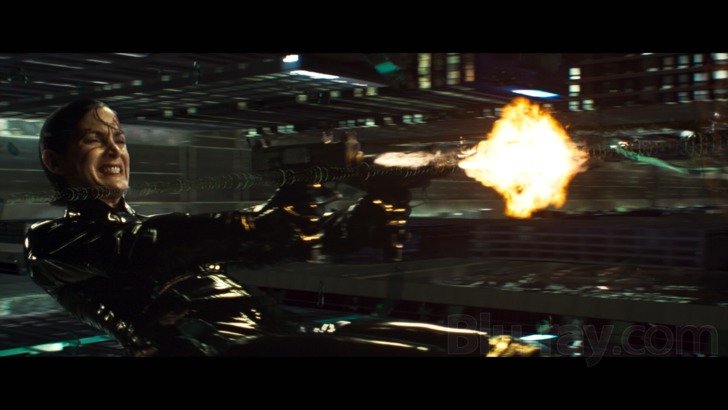
Screenshots accompanying this review are taken from the remastered 1080p standard Blu-ray.
While these images give some sense of the 4K disc's appearance, they cannot hope to represent
its visual subtlety.
According to information provided to me by a Warner Brothers source, this 2160p,
HEVC/H.265-encoded UHD of The Matrix Reloaded is based on a new 4K scan of the original
camera negative created by Warner's Motion Picture Imaging facility. Color correction and HDR
grading were performed by MPI's senior colorist, Jan Yarbrough, and overseen by Bill Pope,
director of photography on all three Matrix films. Reproduced below is the statement from Mr.
Yarbrough regarding the first Matrix film,
which was previously provided by the studio and
(again, according to a Warner Brothers source) applies equally to the two sequels:
The Wachowskis have entrusted the creation of the HDR mastering with the original Director of Photography Bill Pope, ASC. Working with Bill I have come to realize that he has a full understanding and appreciation for the dynamics of the HDR format. The Matrix is created in two worlds: the "real" world in cool blue tones; and the "data" world in ever present green. Now with HDR, this film can be viewed in its futuristic and data centric realm more accurately than previous formats would allow. HDR with its huge dynamic range of luminance and color gamut allows for a true film gamma replication while adding additional dynamic range for accurate highlights and deep detailed blacks. DP Bill Pope has taken advantage of this to create a version with color timing as it was originally intended, crafting a high resolution digital master that is more accurate than the original theatrical release.
In Reloaded and Revolutions, the color distinction between the two realms of "data" and "real" no longer has to be disguised as carefully as it initially was in The Matrix, where the existence of alternate realities was a critical mid-film reveal. Viewers already know to look for the telltale greenish cast that suffuses the simulated world of the matrix, in contrast to the warmer tones and bluish tinge of reality. That doesn't mean, however, that Messrs. Pope and Yarbrough haven't taken every opportunity to fine-tune the palette of the sequels to dial down the green wash of the "data" world and expand the palette of the "real" one. Perhaps the most obvious example is in the Architect's office, a space that exists outside (or between or somewhere other than) both data and reality. The environment and the Architect himself are now white (or off-white), with the green tinge limited to the endless banks of wall monitors showing Neo in various incarnations within the matrix.
The "real" world has more blues than ever, especially among the lights and machinery of Zion, but it also has a rainbow of additional shadings among the underground settlement's citizens and leaders. Wherever you look in the film, in either "data" or "real" scenes, the colors have become more refined and complex than in any previous video presentation I have seen, fully delivering on Mr. Yarbrough's characterization of the HDR master as "more accurate than the original theatrical release".
The UHD's increase in resolution is a huge step up from both the prior Blu-ray and even the remastered 1080p version derived from the new 4K master. Fine detail of faces and textures in clothing is strikingly present in closeups. In long shots of scenes crowded with people and machinery, even those that have been CG-enhanced, the definition and sense of depth are extraordinary. For an excellent example, look at the crowd that Morpheus addresses in Zion; the individual figures are distinct even as the crowd stretches back endlessly. Similarly, the vast reaches of Zion's machinery, when Neo takes his walk with Councillor Hamann, reveal subtleties and refinements not seen since the film first played in theaters (and maybe not even then). The ornate decor of the Merovingian's domain is rendered with such a sense of tactile luxury that you can almost forget what a dubious notion the character really is. (What program created him?) Somewhat to my surprise, even the scenes involving legions of Agent Smiths benefit from the improved clarity. I had expected a sequence like the so-called "Burly Brawl" to look more like a video game than it already did in 1080p, but the effects team did such a fine job combining real and CG stuntmen that the 4K presentation actually enhances the sense of Neo's peril from an ever-growing crowd of Smiths. (The freeway chase doesn't upgrade as cleanly, but much of that is due to motion blur, because everything, including the camera, is perpetually moving.)
In sum, the new presentation of Reloaded matches the visual quality of The Matrix UHD at every turn. Whatever one's opinion of the film, its 4K/HDR version represents the UHD format at its finest. (The disc also contains Dolby Vision encoding, which will be the subject of a separate review.)
[System professionally calibrated using (a) a Klein K-10A Colorimeter with a Custom Profile made in CalMAN using a Colorimetry Research CR250 Spectroradiometer; (b) Murideo Fresco SIX-G UHD signal generator with HDR10 and Dolby Vision capability; and (c) SpectraCal CalMAN Software v. 5.8.2.85. Calibration performed by Kevin Miller of ISFTV.]
The Matrix Reloaded 4K Blu-ray Movie, Audio Quality 
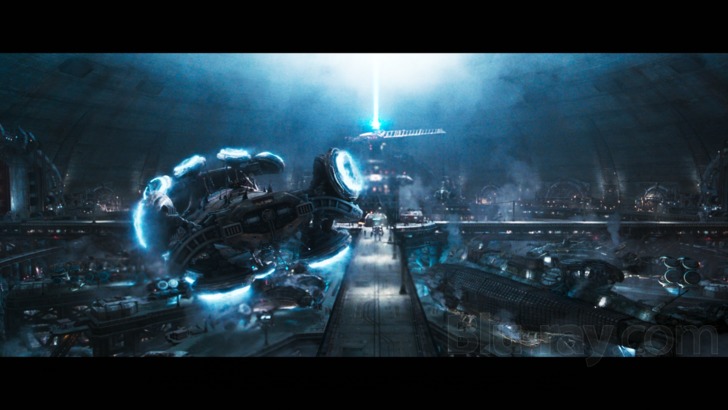
Let's begin with the stupid disc authoring, which was already evident on the 4K disc of The
Matrix but is now becoming an alarmingly established practice at Warner Brothers. You have to
wonder whether the executives in charge of these projects actually play UHD discs, or if these
titles are just more "product" on their balance sheets.
In the early days of Blu-ray, when lossless audio was a relatively new phenomenon, Warner
opted to have its Blu-ray discs default to a lossy Dolby Digital track that would play on pretty
much any variety of equipment that existed in 2006. If the disc happened to offer lossless
audio—Warner preferred Dolby TrueHD in those days—you had to make a point of selecting it.
This was particularly problematic with Warner's early Blu-rays, because they began playing the main
feature immediately. You had to select the popup menu and switch tracks mid-film at whatever
point you remembered (or realized) that you were hearing an inferior sound presentation. It's
worth stressing that Warner was the only major studio to implement this design; Blu-rays from
every other studio defaulted to lossless audio, and people somehow managed to play them
without issue (probably because the lossless formats were designed to be backward-compatible,
as is Dolby Atmos).
Well, at Warner Home Video, it's 2006 all over again. Each of the three Matrix films defaults to
lossy Dolby Digital 5.1, and the only advance from the early days is that the discs start with a
menu instead of immediately playing the feature. But if you don't remember to cursor over to the
"Audio" section and change the soundtrack, you won't get the new Dolby Atmos mix. This
anachronistic authoring choice—and make no mistake; it's a choice—applies to both the UHD
and the remastered 1080p Blu-ray, which also features the new Atmos remix. And once again, Warner is the only studio to adopt this routine practice
of defaulting to a lesser audio track—here, a lossy one—which is just as technologically inept today as it was in 2006.
Once you've selected Atmos, you'll be treated to a remix of the same careful and deliberate
quality as appears on The
Matrix UHD. The
layers of sound aren't different, just better, with each
element of the elaborately engineered sonic environment distinctly audible without being popped
out to the point of distraction. The action begins immediately with Trinity's assault on the power
facility (a sequence that will be repeated at greater length later in the film), which combines
explosions, shattering glass, body blows, gunfire and bullet hits, all neatly positioned and
directionalized. Zion is a full-blown city, continuously humming with life and activity in all
directions. The famous highway chase is a unique demonstration of the mixer's art, combining
realistic sounds of crunching metal and machinery with Don Davis' urgent score and a few eerie
moments of quiet, consistent with the fact that what's happening with these drivers and vehicles
isn't "real". The Merovingian's restaurant/banquet hall is particularly enjoyable, with its
understated clinks of glasses, china and silverware and the quiet swish of fine linens, napkins and
tablecloths—all of it complementing the character's self-satisfied sense of superiority.
Dialogue remains seamlessly integrated and perfectly prioritized, and Davis' scoring and songs
are just as vividly rendered as on The Matrix UHD. This is Atmos done right, and the more
speakers your system has to assist in the object-based placement of the effects, the better it will
sound.
The Matrix Reloaded 4K Blu-ray Movie, Special Features and Extras 
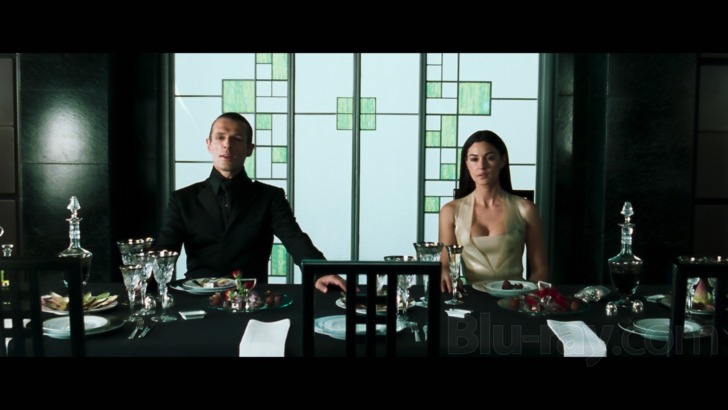
As with The Matrix UHD, Warner has separated the independent special features onto a separate
disc, except that with both Reloaded and Revolutions, they've dropped some of them:
specifically, the films' trailers and TV spots. Who knows why? They've also failed to take
advantage of the extra space now left vacant on the 1080p feature disc to maximize the bitrate,
which clocks in at a measly average of 20.97 Mbps, with over 10 Gbs of space left unused. As
with the audio authoring, it's 2006 all over again. (And once again, these are choices made by the
executives overseeing the project. Perhaps inadvertent choices—certainly ignorant ones—but
choices nonetheless.)
As I did with The Matrix on 4K, I have not attempted to retrace the history of extras that the
series has accumulated over the years. I have simply listed the extras included in the UHD
package, so that readers can make their own comparisons to whatever version(s) they already
own. As an aid to such comparisons, I have also included a listing of the extras previously appearing on the single-disc release
of the original Reloaded Blu-ray that
Warner has now
chosen to omit, even though they would have fit on any one of the three discs in the package.
Also, I have not given this release a rating for extras. What is the point of rating a "feature" so
obviously incomplete that it requires retaining (or acquiring) additional discs just to restore what
should have been there in the first place?
- Commentaries: Both the UHD disc and the standard Blu-ray contain the two audio commentaries from previous editions.
- Written Introduction by the Wachowskis (the same one appears on all three films)
- Philosophers Commentary by Dr. Cornel West and Ken Wilber
- Critics Commentary by Todd McCarthy, John Powers and David Thomson
- In-Movie Experience: This combination of commentary and inset video appears as an option on the remastered 1080p Blu-ray. The 2008 Blu-ray offered the same option.
- Behind the Story
- Behind the Matrix (480i; 1.33:1; 46:57)
- The Matrix Unfolds
- Pre-load
- Get Me an Exit
- The MTV Movie Awards Reloaded
- Car Chase (480i; 1.33:1; 1:26:07)
- The Freeway Chase
- Oakland Streets and Freeway: Unseen Material
- Tour of the Merovingian's Car Garage
- Queen of the Road
- Arteries of the Mega-City: The Visual Effects of the Freeway Chase
- Foresight: Preplanning the Mayhem
- Freeway Truck Crash: Anatomy of a Shot
- Fate of the Freeway
- Freeway Action Match
- Teahouse Fight (480i; 1.33:1; 7:04)
- Two Equals Clash
- Guardian of the Oracle: Collin Chou
- Unplugged (480i; 1.33:1; 40:26)
- Creating the Burly Brawl
- A Conversation with Master Wo Ping
- Chad Strahelski: The Other Neo
- Burly Brawl Action Match
- Spiral Virtual Shot: Anatomy of a Shot
- I'll Handle Them (480i; 1.33:1; 17:10)
- The Great Hall
- Building the Merovingian's Lair
- Tiger Style: A Day in the Life of Chen Hu
- Heavy Metal: Weapons of the Great Hall
- The Exiles (480i; 1.33:1; 17:53)
- The Exiles
- Big Brother Is Watching: The Architect's Office
- Additional Footage
- Enter the Matrix: The Game
- Enter the Matrix (480i; 1.33:1; 42:31)
- Scene 01: Niobe & Ghost Jack In
- Scene 02: Last Transmission of the Osiris
- Scene 03: 72 Hours
- Scene 04: Hallway of the Keymaker
- Scene 05: A Kiss from Niobe
- Scene 06: A Kiss from Ghost
- Scene 07: Clean Exit
- Scene 08: The Logos Returns to Zion
- Scene 09: Lock and Niobe
- Scene 10: Ghost & Trinity, Part 1
- Scene 11: Ghost & Trinity, Part 2
- Scene 12: Lessons of the Oracle
- Scene 13: Off the Freeway
- Scene 14: Sparks Directs Traffic
- Scene 15: Saving Morpheus
- Scene 16: Three Hours to Attack
- Scene 17: EMP Aftermath
- Scene 18: Niobe Visits the Oracle
- Scene 19: Ghost Visits the Oracle
- Scene 20: Niobe Leaves the Oracle
- Scene 21: Ghost Leaves the Oracle
- Scene 22: Picnicking Sentinels
- Scene 23: One Hell of a Ride
- "Sleeping Awake" (480i; 2.35:1, windowboxed; 3:43): A music video by P.O.D.
Now for the omitted features. These were available from the main menu of the original 2008 Blu-ray of Reloaded, which also contained everything listed above.
- Reloaded/Revolutions Teaser
- The Matrix Reloaded Trailer
- The Matrix Reloaded TV Spots
- Yes
- Jack In
- Nice Trick
- Story
- No Escape
- I'm In
- Prophecy
- Neo
Why were these features omitted? It certainly wasn't for lack of space. There are over 10 GB of free space on the "Special Features" disc—enough to contain both these trailers and all (or most) of the additional documentary material assembled for the "2-Disc Databank" included with The Ultimate Matrix Collection. But no. As with the Blade Runner UHD package, the Warner executives in charge apparently have no idea what material is sitting on their own shelves.
The Matrix Reloaded 4K Blu-ray Movie, Overall Score and Recommendation 

There are sequences in the Matrix sequels that I still enjoy, and I suspect I'm not alone in finding
these films more pleasurable in small doses. Neo's encounter with the Architect in Reloaded is
always good for a chuckle; the more you listen to the old man's clipped dialogue, the more
ridiculous it gets—and more entertaining as a result. (It was the first hearing that disappointed;
after so much buildup, the Wachowskis delivered a "payoff" that undid everything the first
film established, leaving the audience to feel cheated and betrayed.) And the early subway station
reunion of Neo and Trinity in Revolutions has the passionate intensity of a great love story, even
more so when you know where the couple is heading.
Taken as a whole, however, the movies are laughable, and never more so than when the two
worlds of "real" and "data" carefully delineated in the first film begin to merge, with Neo's
"data" powers leaking into the "real" world and Agent Smith successfully integrating himself
into a human body. The trilogy's ending is a joke—much like the omitted extras, cramped
bitrates and ignorant authoring decisions featured in these two UHD packages. Don't bother
acquiring them unless you're already equipped for UHD or expect to be soon, because the
remastered 1080p discs aren't that big an upgrade. If you're already UHD-capable, then you
won't be disappointed with the 4K image and sound, but keep your existing Blu-ray sets, and
above all remember to select the Dolby Atmos track, or you'll find yourself wondering why the audio is so ordinary.
Other editions
The Matrix Reloaded: Other Editions

The Matrix Reloaded 4K
2003

The Matrix Reloaded
2003

The Matrix Reloaded
Remastered
2003

The Matrix Reloaded
2003

The Matrix Reloaded
2003

The Matrix Reloaded
2003
Similar titles
Similar titles you might also like

The Matrix Revolutions 4K
2003

The Matrix 4K
1999

The Fifth Element 4K
20th Anniversary Edition
1997

The Animatrix
2003

Terminator Salvation
Director's Cut
2009

Independence Day 4K
20th Anniversary Edition
1996

Tenet 4K
2020

The Day After Tomorrow
2004

Terminator Genisys 4K
2015

G.I. Joe: The Rise of Cobra 4K
2009

Battleship 4K
2012

TRON: Legacy
2010

Terminator 2: Judgment Day 4K
+BD with the 3 versions
1991

Babylon A.D.
2008

2012 4K
2009

The Lost World: Jurassic Park
1997

Serenity 4K
2005

Mad Max: Fury Road 4K
2015

Planet of the Apes
2001

Terminator 3: Rise of the Machines
1080p Corrected Version
2003
